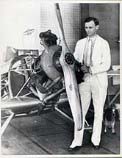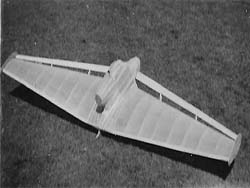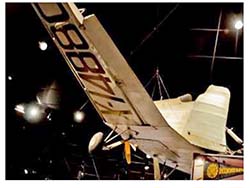AEM Alumnus, Thomas Sontag, Donates John D. Akerman's Flying Wing Blueprint

John D. Akerman with his tailless airplane

Mockup of the Flying Wing

The Flying Wing on display in McNamara Heritage room
The Department would like to thank Thomas Sontag for the donation of the Akerman Flying Wing Blueprint. AEM alum, Thomas Sontag, received a Bachelor of Aerospace Engineering and Mechanics in 1982, and a Master's degree in Civil Engineering in 1991 from the University of Minnesota. Recently, he made a return visit to deliver a blueprint for the tailless airplane known as the Flying Wing. The Flying Wing was built, designed and flown by John D. Akerman, Professor Emeritus and initial Head of the Department of Aeronautical Engineering.
Tailless aircraft, like the Flying Wing, are more fuel efficient than conventional aircraft, but are inherently less stable. Despite this, Akerman didn’t design his aircraft for stability or safety of flight, but rather to involve aeronautical engineering students in the process of constructing aircraft.
In the early 1930’s one of Professor Akerman’s students, Charles Howard Swanson, was particularly involved in this process. While at the University of Minnesota, Charles led a team of 8 other students throughout the process of constructing the aircraft. Together these students completed the design and got about half of the plane built. John Akerman then finished the construction of the plane, and flew it in 1936.
“John Akerman was a very advanced designer, and was the man who designed the first low wing airplane that is now standard,” said Charles Swanson in his autobiography. Charles, who graduated from the University of Minnesota in 1933, stored the blueprint in a box with other model aircraft items. Years later, his daughter Dianne Swanson found the box when she inherited her father’s estate. She then gave it to her handyman, who passed it along to Thomas Sontag when he learned about his interest in aircraft.
“When I went through the box, I found the drawing and carefully unfolded it. The date and the signed name of J.D Akerman caught my eye. After a quick internet search, I found an article entitled ‘Early development of tailless aircraft in the United States’ by E.T Woolridge. There was Akerman sitting in the very same airplane,” says Thomas.
Months later Thomas read that Dr. Garrard was retiring. As a former student of Garrard’s, he decided to reach out to him to see if the department was interested in the blueprint. We were, and after a long chain of events, the blueprint ended up back where it started.
This year, a team of students in the senior design class at AEM have continued the tradition of constructing tailless aircraft by designing, building, and flying a light-weight, tailless, UAV style aircraft to be used in agriculture.Their aircraft operates with a digital control system which allows for the stability and precision that tailless airplanes have lacked in the past. Tailless aircraft have become much more practical with the advent of these digital control systems, and because they are much more fuel efficient than conventional aircraft, they have gained the support of many. In fact, the Department currently has a grant to design, build and fly a large tailless aircraft as part of NASA’s efforts to support more fuel efficient aircraft.
The department has a long history with tailless aircraft, and it all started with Akerman’s Flying Wing blueprint that we are fortunate to now have. The blueprint is set to be displayed in the heritage room of McNamara Alumni Center alongside the Flying Wing aircraft,which is currently on loan from the Smithsonian Air and Space Museum


